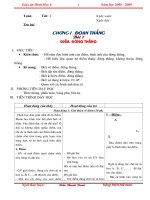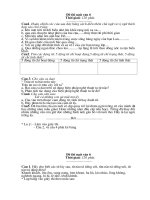IBM Systems Director Release Notes Version 6.3.0 potx
Bạn đang xem bản rút gọn của tài liệu. Xem và tải ngay bản đầy đủ của tài liệu tại đây (177.74 KB, 42 trang )
IBM Systems
IBM Systems Director
Release Notes
Version 6.3.0
IBM Systems
IBM Systems Director
Release Notes
Version 6.3.0
Note
Before using this information and the product it supports, read the information in “Notices” on
page 29.
© Copyright IBM Corporation 2011.
US Government Users Restricted Rights – Use, duplication or disclosure restricted by GSA ADP Schedule Contract
with IBM Corp.
Contents
Chapter 1. Description 1
Chapter 2. Compatibility with earlier
releases 3
Chapter 3. System requirements 7
Chapter 4. Installing IBM Systems
Director 6.3 9
Chapter 5. Known problems 11
Appendix A. Publications and related
information 13
Appendix B. Troubleshooting and
support for IBM Systems Director . . . 17
Techniques for troubleshooting problems 17
Searching knowledge bases (Web search) 19
Getting fixes from Fix Central 20
Contacting IBM Support 21
Exchanging information with IBM 22
Sending information to IBM Support 22
Receiving information from IBM Support . . . 25
Subscribing to Support updates 26
Searching messages 27
Known problems and solutions 28
Notices 29
Trademarks 31
© Copyright IBM Corp. 2011 iii
iv IBM Systems Director Version 6.3 Release Notes
Chapter 1. Description
IBM
®
Systems Director 6.3 includes the following changes:
v Support for additional operating systems
v Fixes for Authorized Program Analysis Reports (APARs) and known problems.
A detailed description of the changes in version 6.3 is available in the “What's new
in version 6.3” topic in the information center.
Related information:
"What's new in version 6.3" in the IBM Systems Director Information Center
© Copyright IBM Corp. 2011 1
2 IBM Systems Director Version 6.3 Release Notes
Chapter 2. Compatibility with earlier releases
Important:
v The version of IBM Systems Director Server must almost always be the same as
or later than the version of any Common Agent or Platform Agent that is
installed on the managed systems. For example, you must install and use IBM
Systems Director Server 6.3 to manage Common Agent 6.3 that is installed on
managed systems, or you must install and use IBM Systems Director Server 6.3
to manage Platform Agent 6.3 that is installed on managed systems.
Note: The only exception to this rule is for AIX
®
. If you update AIX on the
management server, the agent that is installed with the new AIX version might
be newer than the existing version of IBM Systems Director Server. In this case,
ensure that you update IBM Systems Director Server immediately after updating
AIX so that IBM Systems Director Server is again at a level that is the same as or
later than the version of the agent.
v IBM Systems Director version 6.1 or later is not compatible with any versions of
IBM Director Server extensions, IBM Director Console extensions, or IBM
Director Agent extensions that are supported by IBM Director version 5.20.x or
earlier. Therefore, you must first uninstall those extensions before you install or
upgrade an IBM Systems Director component from version 5.20.x to version
6.1.x, 6.2.x, or 6.3.x. For detailed information, see What's new in version 6.3.2.
v If you must run a version of IBM Director or IBM Systems Director that is older
than the version that is currently installed, you cannot update or migrate to it.
You must instead uninstall your current version and then install the older
version.
See the following table for a complete listing of previous agent versions that are
compatible with and can be managed by IBM Systems Director Server.
Table 1. Compatibility of IBM Systems Director Server with previous agent versions
For Power Systems
™
servers:
Compatible
Agent-
managed
systems
IBM
Systems
Director
Server
version 6.3.2
IBM
Systems
Director
Server
version 6.3.1
IBM
Systems
Director
Server
version 6.3.0
IBM
Systems
Director
Server
version
6.2.1
IBM
Systems
Director
Server
version 6.2.0
IBM
Systems
Director
Server
version
6.1.2.x
IBM
Systems
Director
Server
version
6.1.1.x
IBM
Systems
Director
Server
version 6.1
Common
Agent for
AIX
6.1.0.x - 6.1.2.x
6.2.0.x - 6.2.1.x
6.3
5.20.2
6.1.0.x - 6.1.2.x
6.2.0.x - 6.2.1.x
6.3
5.20.2
6.1.0.x - 6.1.2.x
6.2.0.x - 6.2.1.x
6.3
5.20.2
6.1 - 6.1.2
6.2 - 6.2.1
5.20.2
6.1 - 6.1.2
6.2
5.20.2
6.1 - 6.1.2
5.20.2
6.1.0.3 - 6.1.1.x
5.20.2
6.1
Common
Agent for
VIOS
6.1.0.3 - 6.1.2.x
6.2.0.x - 6.2.1.x
6.3
6.1.0.3 - 6.1.2.x
6.2.0.x - 6.2.1.x
6.3
6.1.0.3 - 6.1.2.x
6.2.0.x - 6.2.1.x
6.3
6.1.0.3 - 6.1.2
6.2 - 6.2.1
6.1.0.3 - 6.1.2
6.2
6.1.0.3 - 6.1.2 6.1.0.3 - 6.1.1.x6.1.0.3
Platform
Agent for
AIX
n/a n/a n/a n/a n/a n/a n/a n/a
Common
Agent for
Linux on
Power
Systems
6.1 - 6.1.2
6.2 - 6.2.1
6.3
5.20.2
6.1 - 6.1.2
6.2 - 6.2.1
6.3
5.20.2
6.1 - 6.1.2
6.2 - 6.2.1
6.3
5.20.2
6.1 - 6.1.2
6.2 - 6.2.1
5.20.2
6.1 - 6.1.2
6.2
5.20.2
6.1 - 6.1.2
5.20.2
6.1 - 6.1.1.x
5.20.2
6.1
© Copyright IBM Corp. 2011
3
Table 1. Compatibility of IBM Systems Director Server with previous agent versions (continued)
For Power Systems
™
servers:
Compatible
Agent-
managed
systems
IBM
Systems
Director
Server
version 6.3.2
IBM
Systems
Director
Server
version 6.3.1
IBM
Systems
Director
Server
version 6.3.0
IBM
Systems
Director
Server
version
6.2.1
IBM
Systems
Director
Server
version 6.2.0
IBM
Systems
Director
Server
version
6.1.2.x
IBM
Systems
Director
Server
version
6.1.1.x
IBM
Systems
Director
Server
version 6.1
Platform
Agent for
Linux on
Power
Systems
6.1.2
6.2 - 6.2.1
6.3 - 6.3.1
5.20.3
6.1.2
6.2 - 6.2.1
6.3 - 6.3.1
5.20.3
6.1.2
6.2 - 6.2.1
6.3
5.20.3
6.1 - 6.1.2
6.2 - 6.2.1
5.20.3
6.1 - 6.1.2
6.2
5.20.3
6.1 - 6.1.2
5.20.3
6.1 - 6.1.1.x
5.20.3
6.1
Common
Agent for
IBM i
1
6.1.2
(5722-UME
V1R2)
6.2.x
(5770-UME
V1R3)
6.3
(5770-UME
V1R3)
6.3.2
(5770-UME
V1R3)
6.1.2
(5722-UME
V1R2)
6.2.x
(5770-UME
V1R3)
6.3
(5770-UME
V1R3)
6.1.2
(5722-UME
V1R2)
6.2.x
(5770-UME
V1R3)
6.3
(5770-UME
V1R3)
5.20.2
6.1.2
(5722-UME
V1R2)
6.2 - 6.2.1
(5770-UME
V1R3)
5.20.2
6.1.2
(5722-UME
V1R2)
6.2
(5770-UME
V1R3)
5.20.2
6.1.2
(5722-UME
V1R2)
5.20.2 5.20.2
IBM i
Platform
Agent
1
IBM i 5.4:
5722-UME
V1R2
IBM i 6.1:
5770-UME
V1R3
IBM i 7.1:
5770-UME
V1R3
IBM i 5.4:
5722-UME
V1R2
IBM i 6.1:
5770-UME
V1R3
IBM i 7.1:
5770-UME
V1R3
IBM i 5.4:
5722-UME
V1R2
IBM i 6.1:
5770-UME
V1R3
IBM i 7.1:
5770-UME
V1R3
5722–UME
V1R2
5770-UME
V1R3
5722–UME
V1R2
5770-UME
V1R3
5722–UME
V1R2
5770-UME
V1R3
5722–UME
V1R2
5722–UME
V1R2
For System x
®
servers:
Compatible
Agent-
managed
systems
IBM
Systems
Director
Server
version 6.3.2
IBM
Systems
Director
Server
version 6.3.1
IBM
Systems
Director
Server
version 6.3.0
IBM
Systems
Director
Server
version
6.2.1
IBM
Systems
Director
Server
version 6.2.0
IBM
Systems
Director
Server
version
6.1.2.x
IBM
Systems
Director
Server
version
6.1.1.x
IBM
Systems
Director
Server
version 6.1
Common
Agent for
Windows
5.20 - 5.20.3
6.1 - 6.1.2
6.2 - 6.2.x
6.3 - 6.3.2
5.20 - 5.20.3
6.1 - 6.1.2
6.2 - 6.2.x
6.3
5.20 - 5.20.3
6.1 - 6.1.2
6.2 - 6.2.x
6.3
5.20 - 5.20.3
6.1 - 6.1.2
6.2 - 6.2.1
5.20 - 5.20.3
6.1 - 6.1.2
6.2
5.20 - 5.20.3
6.1 - 6.1.2
5.20 - 5.20.3
6.1 - 6.1.1.x
5.20 - 5.20.3
6.1
Platform
Agent for
Windows
5.20 - 5.20.3
6.1.1 - 6.1.2
6.2 - 6.2.x
6.3 - 6.3.2
5.20 - 5.20.3
6.1.1 - 6.1.2
6.2 - 6.2.x
6.3 - 6.3.1
5.20 - 5.20.3
6.1.1 - 6.1.2
6.2 - 6.2.x
6.3
5.20 - 5.20.31
6.1.1 - 6.1.2
6.2 - 6.2.1
5.20 - 5.20.31
6.1.1 - 6.1.2
6.2
5.20 - 5.20.31
6.1.1 - 6.1.2
5.20 - 5.20.31
6.1.1 - 6.1.1.x
5.20 - 5.20.31
Common
Agent for
Linux on
System x
5.20.31-5.20.32
6.1 - 6.1.2
6.2 - 6.2.1
6.3 - 6.3.2
5.20.31-5.20.32
6.1 - 6.1.2
6.2 - 6.2.1
6.3
5.20.31-5.20.32
6.1 - 6.1.2
6.2 - 6.2.1
6.3
5.20 - 5.20.3
6.1 - 6.1.2
6.2 - 6.2.1
5.20 - 5.20.3
6.1 - 6.1.2
6.2
5.20 - 5.20.3
6.1 - 6.1.2
5.20 - 5.20.3
6.1 - 6.1.1.x
5.20 - 5.20.3
6.1
Platform
Agent for
Linux on
System x
5.20.31-5.20.32
6.1.1 - 6.1.2
6.2 - 6.2.1
6.3 - 6.3.2
5.20.31-5.20.32
6.1.1 - 6.1.2
6.2 - 6.2.1
6.3 - 6.3.1
5.20.31-5.20.32
6.1.1 - 6.1.2
6.2 - 6.2.1
6.3
5.20 - 5.20.31
6.1.1 - 6.1.2
6.2 - 6.2.1
5.20 - 5.20.31
6.1.1 - 6.1.2
6.2
5.20 - 5.20.31
6.1.1 - 6.1.2
5.20 - 5.20.31
6.1.1 - 6.1.1.x
5.20 - 5.20.31
For System z
®
servers:
4 IBM Systems Director Version 6.3 Release Notes
Table 1. Compatibility of IBM Systems Director Server with previous agent versions (continued)
For Power Systems
™
servers:
Compatible
Agent-
managed
systems
IBM
Systems
Director
Server
version 6.3.2
IBM
Systems
Director
Server
version 6.3.1
IBM
Systems
Director
Server
version 6.3.0
IBM
Systems
Director
Server
version
6.2.1
IBM
Systems
Director
Server
version 6.2.0
IBM
Systems
Director
Server
version
6.1.2.x
IBM
Systems
Director
Server
version
6.1.1.x
IBM
Systems
Director
Server
version 6.1
Compatible
Agent-
managed
systems
IBM
Systems
Director
Server
version 6.3.2
IBM
Systems
Director
Server
version 6.3.1
IBM
Systems
Director
Server
version 6.3.0
IBM
Systems
Director
Server
version
6.2.1
IBM
Systems
Director
Server
version 6.2.0
IBM
Systems
Director
Server
version
6.1.2.x
IBM
Systems
Director
Server
version
6.1.1.x
IBM
Systems
Director
Server
version 6.1
Common
Agent for
Linux on
System z
6.1-6.1.2
6.2-6.2.1
6.3-6.3.2
5.20.32
6.1 - 6.1.2
6.2 - 6.2.1
6.3
5.20.32
6.1 - 6.1.2
6.2 - 6.2.1
6.3
5.20.32
6.1 - 6.1.2
6.2 - 6.2.1
5.20.32
6.1 - 6.1.2
6.2
5.20.32
6.1
5.20.32
6.1
5.20.32
6.1
Platform
Agent for
Linux on
System z
6.2.1
6.3-6.3.2
5.20.32
6.2.1
6.3
5.20.32
6.2.1
6.3
5.20.32
6.2.1
5.20.32 5.20.32 5.20.32 5.20.32
IBM z/VM
®
Manageability
Access Point
Agent for
System z
6.3.2 6.3 6.3 6.2.1 6.2 6.1.1 6.1.1 6.1
1. For more information about the compatibility of IBM Systems Director Server
with IBM i agent versions, see Using IBM i resources with an IBM Systems
Director Server.
Chapter 2. Compatibility with earlier releases 5
6 IBM Systems Director Version 6.3 Release Notes
Chapter 3. System requirements
For information about IBM Systems Director system requirements, see the
following topics in the “Planning” section of the information center.
Planning
Hardware and software requirements (Specified operating
environments)
Hardware requirements for IBM Systems Director
Network requirements
Operating system and software requirements
© Copyright IBM Corp. 2011 7
8 IBM Systems Director Version 6.3 Release Notes
Chapter 4. Installing IBM Systems Director 6.3
For step-by-step installation instructions, see these topics in the information center.
Planning
Planning to install IBM Systems Director
Planning to update IBM Systems Director
Installing
Installing IBM Systems Director on the management server
Installing agents
Upgrading and migrating IBM Systems Director
Configuring IBM Systems Director Server after installation
Uninstalling IBM Systems Director
© Copyright IBM Corp. 2011 9
10 IBM Systems Director Version 6.3 Release Notes
Chapter 5. Known problems
Information about how to troubleshoot and resolve problems with IBM Systems
Director is documented in the “Troubleshooting” section of the information center.
Additional troubleshooting and workaround information can be found in the "IBM
Systems Director Tech Notes" on the support site.
Related information:
Troubleshooting and support
IBM Systems Director Tech Notes
© Copyright IBM Corp. 2011 11
12 IBM Systems Director Version 6.3 Release Notes
Appendix A. Publications and related information
You can view the same content in the IBM Systems Director Information Center as
PDF documents. To view a PDF file, you need Adobe Acrobat Reader, which can
be downloaded for free from the Adobe Web site at />Information centers and topic collections
v IBM Systems
/>View the IBM Systems information center landing page, which provides
integrated information for multiple IBM Systems products.
v IBM Systems Director
publib.boulder.ibm.com/infocenter/director/pubs/index.jsp
Updated periodically, the IBM Systems Director topic collection contains the
most up-to-date documentation available for IBM Systems Director.
v IBM Systems Director plug-ins
/>extensionparent.html
View the IBM Systems information center for information about how to install
and use plug-ins that extend the functionality of IBM Systems Director.
v IBM Systems Director Upward Integration Modules (UIMs)
publib.boulder.ibm.com/infocenter/systems/topic/uims/fqs0_main.html
Read the IBM Systems Director Upward Integration Modules (UIM) topic
collection to learn about how to install and use upward integration modules and
management packs that enable non-IBM workgroup and enterprise-management
products to interpret and display data that is provided by Common Agent and
Platform Agent.
v IBM Systems Director API Licensing
/>View the license information regarding use of IBM Systems Director APIs and
their associated documentation. Fill out the form to request API access. After
your information is reviewed, you will be contacted with additional information
regarding access to and use of the APIs.
Publications
Release Notes 6.3.2
Provides an easy reference to planning, install and troubleshooting
information for IBM Systems Director
IBM Systems Director Planning Guide
Provides planning information, including hardware requirements for
running IBM Systems Director components, supported IBM Systems
Director hardware, operating systems, databases, and workgroup and
enterprise systems-management software.
PDF files for installing IBM Systems Director Server
Provides detailed instructions to prepare for, install, and configure the IBM
Systems Director Server.
© Copyright IBM Corp. 2011 13
PDF files for installing IBM Systems Director agents
Provides detailed instructions to prepare for and install IBM Systems
Director agents on your managed systems, as well as, prepare for agentless
managed systems.
PDF files for upgrading and migrating IBM Systems Director Server
Provides detailed instructions to upgrade and migrate the IBM Systems
Director Server.
PDF files for upgrading and migrating IBM Systems Director agents
Provides detailed instructions to upgrade and migrate IBM Systems
Director agents.
Systems Management Guide
Provides detailed instructions for using the Web interface and managing
systems and resources in your environment.
Troubleshooting Guide
Provides information about problems and how to solve them, and
strategies for troubleshooting common problems.
Events Reference
Provides information about IBM Systems Director events, including the
event type, description, severity, and extended details.
Commands Reference
Provides detailed information about the systems management
command-line interface (smcli) commands, and other commands that can
be run directly from the command line, including configuring the database,
and starting and stopping IBM Systems Director.
Hardware Command Line User's Guide
Provides information about installing and using the Hardware Command
Line (formerly known as the IBM Management Processor Command-Line
Interface). Command output in this release might vary from command
output in previous releases.
White papers and briefs
v IBM Systems Director
/>XBW03006USEN.PDF
This paper provides a detailed overview of the changes in IBM Systems Director
V6.1, including the new Web interface, security features, operating system
agents, integrated plug-ins and additional plug-ins that can be separately
installed.
v Value Proposition for IBM Systems Director
/>XBW03007USEN.PDF
This paper describes the challenges of operational management for enterprise
server installations and the value provided IBM Systems Director.
v Performance Tuning and Scaling Guide for IBM Systems Director 6.3
Hardware requirements for running IBM Systems Director Server
Provides information about how to plan, implement, configure, and use an IBM
Systems Director Server to manage a large configuration with optimal
performance. The Performance Tuning and Scaling Guide also contains
information about the following topics:
14 IBM Systems Director Version 6.3 Release Notes
– Running IBM Systems Director plug-ins, such as IBM Systems Director Active
Energy Manager
®
and IBM Scalable Systems Manager
– Integration with Tivoli
®
products
– Implementing high availability
IBM Redbooks
®
publications
www.ibm.com/redbooks/
You can also search this Web page for documents that focus on IBM Systems
Director and specific IBM hardware; such documents often contain
systems-management material. The following book is available for IBM Systems
Director V6.1:
Implementing IBM Systems Director 6.1
Tip: Be sure to note the date of publication and to determine the version of IBM
Systems Director software to which the Redbooks publication refers.
Further information
See Searching knowledge bases for more resources for further information about
IBM Systems Director.
Appendix A. Publications and related information 15
16 IBM Systems Director Version 6.3 Release Notes
Appendix B. Troubleshooting and support for IBM Systems
Director
To isolate and resolve problems with your IBM products, you can use the
troubleshooting and support information. This information contains instructions for
using the problem-determination resources that are provided with your IBM
products, including IBM Systems Director.
Use this section to troubleshoot and resolve problems with IBM Systems Director
6.2 or later. To troubleshoot problems that are specific to earlier versions of IBM
Systems Director, see the documentation for that version.
Techniques for troubleshooting problems
Troubleshooting is a systematic approach to solving a problem. The goal of
troubleshooting is to determine why something does not work as expected and
how to resolve the problem. Certain common techniques can help with the task of
troubleshooting.
The first step in the troubleshooting process is to describe the problem completely.
Problem descriptions help you and the IBM technical-support representative know
where to start to find the cause of the problem. This step includes asking yourself
basic questions:
v What are the symptoms of the problem?
v Where does the problem occur?
v When does the problem occur?
v Under which conditions does the problem occur?
v Can the problem be reproduced?
The answers to these questions typically lead to a good description of the problem,
which can then lead you to a problem resolution.
What are the symptoms of the problem?
When starting to describe a problem, the most obvious question is “What is the
problem?” This question might seem straightforward; however, you can break it
down into several more-focused questions that create a more descriptive picture of
the problem. These questions can include:
v Who, or what, is reporting the problem?
v What are the error codes and messages?
v How does the system fail? For example, is it a loop, hang, crash, performance
degradation, or incorrect result?
Where does the problem occur?
Determining where the problem originates is not always easy, but it is one of the
most important steps in resolving a problem. Many layers of technology can exist
between the reporting and failing components. Networks, disks, and drivers are
only a few of the components to consider when you are investigating problems.
© Copyright IBM Corp. 2011 17
The following questions help you to focus on where the problem occurs to isolate
the problem layer:
v Is the problem specific to one platform or operating system, or is it common
across multiple platforms or operating systems?
v Is the current environment and configuration supported?
v Do all users have the problem?
v (For installations across multiple sites.) Do all sites have the problem?
If one layer reports the problem, the problem does not necessarily originate in that
layer. Part of identifying where a problem originates is understanding the
environment in which it exists. Take some time to completely describe the problem
environment, including the operating system and version, all corresponding
software and versions, and hardware information. Confirm that you are running
within an environment that is a supported configuration; many problems can be
traced back to incompatible levels of software that are not intended to run together
or have not been fully tested together.
When does the problem occur?
Develop a detailed timeline of events leading up to a failure, especially for those
cases that are singular occurrences. You can most easily develop a timeline by
working backward: Start at the time an error was reported (as precisely as possible,
even down to the millisecond), and work backward through the available logs and
information. Typically, you need to look only as far as the first suspicious event
that you find in a diagnostic log.
To develop a detailed timeline of events, answer these questions:
v Does the problem happen only at a certain time of day or night?
v How often does the problem happen?
v What sequence of events leads up to the time that the problem is reported?
v Does the problem happen after an environment change, such as upgrading or
installing software or hardware?
Responding to these types of questions can give you a frame of reference in which
to investigate the problem.
Under which conditions does the problem occur?
Knowing which systems and applications are running at the time that a problem
occurs is an important part of troubleshooting. These questions about your
environment can help you to identify the root cause of the problem:
v Does the problem always occur when the same task is being performed?
v Does a certain sequence of events need to happen for the problem to occur?
v Do any other applications fail at the same time?
Answering these types of questions can help you explain the environment in
which the problem occurs and correlate any dependencies. Remember that just
because multiple problems might have occurred around the same time, the
problems are not necessarily related.
18 IBM Systems Director Version 6.3 Release Notes
Can the problem be reproduced?
From a troubleshooting standpoint, the ideal problem is one that can be
reproduced. Typically, when a problem can be reproduced you have a larger set of
tools or procedures at your disposal to help you investigate. Consequently,
problems that you can reproduce are often easier to debug and solve.
However, problems that you can reproduce can have a disadvantage: If the
problem is of significant business impact, you do not want it to recur. If possible,
recreate the problem in a test or development environment, which typically offers
you more flexibility and control during your investigation.
v Can the problem be recreated on a test system?
v Are multiple users or applications encountering the same type of problem?
v Can the problem be recreated by running a single command, a set of commands,
or a particular application?
Searching knowledge bases (Web search)
You can often find solutions to problems by searching IBM knowledge bases. You
can optimize your results by using available resources, support tools, and search
methods.
You can find useful information by searching the information center for IBM
Systems Director. However, sometimes you need to look beyond the information
center to answer your questions or resolve problems.
To search knowledge bases for information that you need, use one or more of the
following approaches:
v Find the content that you need by using the IBM Support Portal at
www.ibm.com/support/us.
The IBM Support Portal is a unified, centralized view of all technical support
tools and information for all IBM systems, software, and services. The IBM
Support Portal lets you access the IBM electronic support portfolio from one
place. You can tailor the pages to focus on the information and resources that
you need for problem prevention and faster problem resolution. Familiarize
yourself with the IBM Support Portal by viewing the related demo videos at
/>These videos introduce you to the IBM Support Portal, explore troubleshooting
and other resources, and demonstrate how you can tailor the page by moving,
adding, and deleting portlets.
v Search for content about IBM Systems Director by using one of the following
additional technical resources:
– The Techdocs Web site at />atsmastr.nsf/Web/Techdocs provides white papers, technotes, tips, and other
documents related to IBM Systems Director.
Tip: To locate the information that you need, either select the categories that
you want to search or select UNMARKED to search all categories. Then enter
“IBM Systems Director” in the for: field and click Search.
– The IBM Systems Director customer forum at www.ibm.com/
developerworks/forums/forum.jspa?forumID=759 provides a place for
customers to share ideas and solutions for IBM Systems Director
implementations. It serves as the forum for IBM Systems Director installations
on all supported operating systems and hardware. Although participating in
Appendix B. Troubleshooting and support 19









